2. 中国地震局地球物理研究所, 北京 100081
2. Institute of Geophysics, China Earthquake Administration, Beijing 100081, China
在地震学的研究初期考虑到理论推导和数值计算的可行性与简便性,我们一般把地球介质假设成各向同性的,发展了基于各向同性的地震学方法,并日趋成熟.然而现实中介质从微观到宏观,结构上的差异普遍性地存在,地球内部也不例外.大量的观测和理论已经证实,实际地球内部广泛表现为各向异性.所谓地震波各向异性,简单来讲,是指地震波速度随入射方位角的改变而改变,其中方位各向异性是较早发现且得到证实 (Hess,1964;Raitt et al., 1969).Smith和Dahlen (1973, 1975) 给出了方位各向异性的基本理论以及计算方法,到目前为止有关方位各向异性的研究 (Ekström and Dziewonski, 1998; Trampert和Woodhouse, 2003;Debayle et al., 2005; 彭艳菊等,2007;Yao et al., 2010;易桂喜等,2010;王琼等,2015) 基本源于此理论基础.由于其主要通过调和张量分解来求解各向异性系数,计算过程相对比较复杂和繁琐.Montagner和Nataf (1986)在此基础上提出了一种改进的简便易行的方法:通过将各向异性项系数转换成基于笛卡尔坐标系下弹性参数的函数来表述,大大简化了繁冗的计算,从而为方位各向异性的便捷计算奠定了基础.Montagner和Nataf (1986)仅给出了Love波的简要计算过程,本文则给出了Rayleigh波相速度方位各向异性的计算及详细推导.通过实例反演了蒙古中南部地区的Rayleigh波相速度方位各向异性,并对其揭示的构造演化意义进行了初步探讨.
1 基本公式与约定在笛卡尔坐标系下,无扰动的Rayleigh波的位移表达式为

|
(1) |
其中V(z) 与U(z) 分别是Rayleigh波水平向与垂直向位移关于深度的特征函数, k是水平传播的波数,θ是波矢量的方位角 (自北向顺时针起算),ω是角频率.
考虑在水平层状弱各向异性介质中,在一阶扰动下,Rayleigh波相速度与方位角的关系为 (Smith和Dahlen, 1973, 1975):

|
(2) |
其中ω是角频率,θ是波数矢量的方位角 (以正北顺时针起算)(图 1).C0(ω, θ) 是无扰动下的参考相速度,Ai(ω) 是一系列关于深度的特征函数.

|
图 1 笛卡尔坐标系 (x, y, z) 的定义形式 Figure 1 Definition form of Cartesian coordinate system (x, y, z) |
上述关于相速度的表达式可以简写为

|
(3) |
其中k是波矢量的模,C0(k) 是在各向同性下的相速度,δC(k, θ) 是相速度频散的一阶扰动量.
根据弹性力学几何方程,应变张量为

|
(4) |
按照Rayleigh原理,Smith和Dahlen (1973)给出的相速度一阶扰动表达式为

|
(5) |
其中uk和εij分别表示无扰动下半空间内的位移量和应变量,ρ为密度,星号表示复共轭 (下同).
考虑到张量γ(z) 和ε的复杂性和对称性,我们这里采用简化的下标标记表述cpq和εp分别代替γijkl和εij.由原张量简化下标变换原则为

|
同时我们必须留意到cpq可能有多个对应相等的γijkl,所以需要加上相等系数的个数npq,即γijkl由npqcpq替代.经替代变换后,(5) 式可以写为

|
(6) |
下面我们对 (6) 进行计算.首先统计npq.引入下标简化形式,即
ξ1=ξ(11); ξ2=ξ(22); ξ3=ξ(33); ξ4=ξ(32); ξ5=ξ(31); ξ6=ξ(21).
同时根据对称性有
C12=C21; C13=C31; C32=C23;C14=C41;C24=C42;C43=C34.
通过展开和统计可以得到npq的个数,见表 1,这里给出一个示例:
|
|
表 1 简化下标后计算得到的nij和cijξiξj*(Rayleigh波) Table 1 nij and cijξiξj* are obtained after simplified coordinates (Rayleigh wave) |
对于n56对应的系数有
γ(3121)=γ(1321)=γ(3112)=γ(1312)=γ(2131)=γ(2113)=γ(1231)=γ(1213).
则n56=8.
2 应变量的计算为简便起见,约定:

|
下面计算Rayleigh波的应变量.公式为
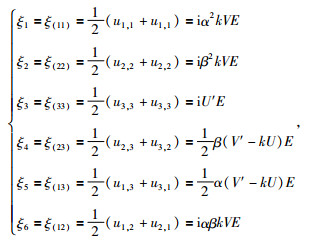
|
式中U′、V′分别表示对U和V在z方向求导.
接下来计算ξiξj*, 详细计算过程不再赘述,这里只给出结果,见表 1.需注意E=exp (i[k(xcosθ+ysinθ)-ωt]) 与其复共轭的乘积为1.
3 扰动量的计算通过上述计算,方程 (6) 中所有nijcijξiξj*项都在表 1中已给出.当cijξiξj*为纯虚数时,它对相速度的扰动量δC(k, θ) 是没有贡献的.对有贡献的项进行相加整理,最终得到基于弹性参数的Rayleigh波相速度一阶扰动量δCR(k, θ) 与方位角θ的关系式,类似于傅里叶展开式且只含有θ的偶数项,公式为
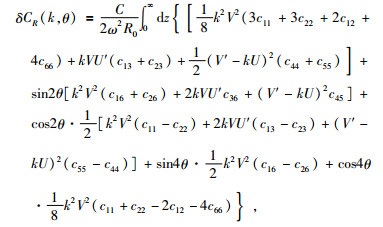
|
(7) |
其中
这里我们引入由弹性系数组合而来的13个对应一定物理现象的参数:A,C,F,L,N,Bc,Bs,Gc,Gs,Hc,Hs,Ec和Es.前5个参数即是横向各向同性下的弹性参数,与径向各向异性相关;后8个弹性参数与方位各向异性相关.详细定义与物理含义可参考Montagner和Nataf (1986),Smith和Dahlen (1973, 1975).在横向各向同性介质中A,C,L,N可以由P波和S波的速度求得.具体系数定义及其关系如下:
(1) 0θ-各向同性项:
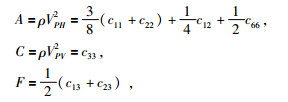
|

|
(2) 2θ-方位各向异性项:
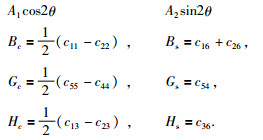
|
(3) 4θ-方位各向异性项:
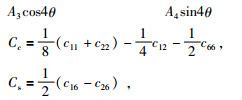
|
其中ρ是密度,VPH2、VPV2分别是P波在水平向与垂直向的传播速度,VSV2、VSH2分别是水平向与垂直向极化的S波速度.
将上述关系式代入 (7) 替换下弹性参数,同时注意相速度

|
(8) |
其中:
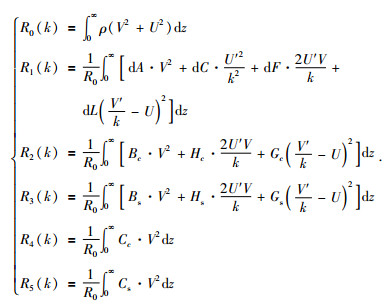
|
采用上述推导给出的计算方法,基于已有的研究基础,我们在蒙古中南部地区进行了应用.由于Rayleigh波相速度的方位各向异性主要对上文中2θ项敏感,而Love波相速度则主要对4θ项敏感且绝对值很小 (Montagner and Nataf, 1986).所以这里我们只计算了稳健的Rayleigh波0θ和2θ项.在之前的研究中,我们采用小波变换时频分析技术测定了双台间Rayleigh波相速度 (余大新等,2015).经过反演后,我们获得了Rayleigh波二维相速度及其方位各向异性,这里不做全面分析,只展示了20 s周期的结果 (图 1).从图中我们可以看到,蒙古-鄂霍茨克缝合带 (MOS) 北部地区方位各向异性主要表现为北北西向或近北向,近似垂直于贝加尔裂谷,与横波分裂获得的快波方向较为一致 (强正阳等,2016).初步推断该区域的应力场可能受到贝加尔裂谷的控制.在研究区中部,各向异性方向杂乱且强度偏弱,横波分裂出现大量的无效分裂 (强正阳等, 2016),结合地质资料及相速度分布 (余大新等,2015),推测该区域可能存在垂向地幔流动.已有研究显示,存在垂直地幔流时就会表现出强烈的径向各向异性和弱的、无序的方位各向异性 (Montagner, 1994;Sebai et al, 2006),因此还需要我们进一步开展径向各向异性进行佐证.而在蒙古中央主断裂带 (MML) 以南的地区,方位各向异性集中表现为北北东方向,该地区地表也呈现出北北东向缩短的特征 (Dickson Cunningham et al., 1996; Calais et al., 2003).Tapponnier和Molnar (1979)认为蒙古高原的变形受到印度-欧亚板块碰撞挤压影响,因此可能暗示该区域地壳内的方位各向异性分布可能跟印度-欧亚板块碰撞产生的远程效应有关.
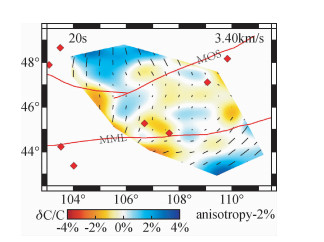
|
图 2 20 s周期Rayleigh波相速度与方位各向异性分布 红色钻石形代表火山岩出露 (IAVCEI, 1973;Whitford-Stark, 1987),红色粗线表示构造线 (Badarch et al., 2002),MOS表示蒙古-鄂霍茨克缝合带 (Mongol-Okhotsk Suture),MML表示蒙古主断裂带 (Main Mongolian Lineament). Figure 2 Rayleigh wave phase velocity maps with anisotropy at period of 20 s The red diamonds indicate the volcano fields (IAVCEI, 1973; Whitford-Stark, 1987). The red bold lines represent main defaults (Badarch et al., 2002). Abbreviation on the map are as following: MOS, Mongol-Okhotsk Suture; MML, Main Mongolian Lineament. |
本文对Rayleigh波相速度方位各向异性的计算给出了详细推导过程,并在蒙古中南部地区开展了相速度方位各向异性结构的研究.结果显示相速度方位各向异性可以很好地反映区域内的构造应力特征,对揭示研究区内的构造演化动力学机制提供了重要的线索.
致谢 感谢各位审稿老师的宝贵指导意见.| [] | Badarch G, Dickson Cunningham W, Windley B F. 2002. A new terrane subdivision for Mongolia:Implications for the Phanerozoic crustal growth of Central Asia[J]. Journal of Asian Earth Sciences, 21(1): 87–110. DOI:10.1016/S1367-9120(02)00017-2 |
| [] | Calais E, Vergnolle M, San'kov V, et al. 2003. GPS measurements of crustal deformation in the Baikal-Mongolia area (1994-2002):Implications for current kinematics of Asia[J]. Journal of Geophysical Research:Solid Earth (1978-2012), 108(B10). DOI:10.1029/2002JB002373 |
| [] | Debayle E, Kennett B, Priestley K. 2005. Global azimuthal seismic anisotropy and the unique plate-motion deformation of Australia[J]. Nature, 433(7025): 509–512. DOI:10.1038/nature03247 |
| [] | Dickson Cunningham W, Windley B F, Dorjnamjaa D, et al. 1996. A structural transect across the Mongolian Western Altai:Active transpressional mountain building in central Asia[J]. Tectonics, 15(1): 142–156. DOI:10.1029/95TC02354 |
| [] | Ekström G, Dziewonski A M. 1998. The unique anisotropy of the Pacific upper mantle[J]. Nature, 394(6689): 168–172. DOI:10.1038/28148 |
| [] | IAVCEI. 1973. Post-miocene volcanoes of the world. IAVCEI data sheets[M]. Rome:International Association of Volcanology and Chemistry of the Earth's Interior. |
| [] | Montagner J P. 1994. Can seismology tell us anything about convection in the mantle[J]. Reviews of Geophysics, 32(2): 115–137. DOI:10.1029/94RG00099 |
| [] | Montagner J P, Nataf H C. 1986. A simple method for inverting the azimuthal anisotropy of surface waves[J]. Journal of Geophysical Research:Solid Earth (1978-2012), 91(B1): 511–520. DOI:10.1029/JB091iB01p00511 |
| [] | Peng Y J, Huang Z X, Su W, et al. 2007. Anisotropy in crust and upper mantle beneath China continent and its adjacent seas[J]. Chinese Journal of Geophysics, 50(3): 752–759. DOI:10.3321/j.issn:0001-5733.2007.03.014 |
| [] | Qiang Z Y, Wu Q J, Li Y H, et al. 2016. Crustal anisotropy beneath central-south Mongolia and its dynamic implications[J]. Chinese Journal of Geophysics, 59(5): 1616–1628. DOI:10.6038/cjg20160507 |
| [] | Raitt R W, Shor Jr G G, Francis T J G, et al. 1969. Anisotropy of the Pacific upper mantle[J]. Journal of Geophysical Research, 74(12): 3095–3109. DOI:10.1029/JB074i012p03095 |
| [] | Sebai A, Stutzmann E, Montagner J P, et al. 2006. Anisotropic structure of the African upper mantle from Rayleigh and Love wave tomography[J]. Physics of the Earth and Planetary Interiors, 155(1-2): 48–62. DOI:10.1016/j.pepi.2005.09.009 |
| [] | Smith M L, Dahlen F A. 1973. The azimuthal dependence of Love and Rayleigh wave propagation in a slightly anisotropic medium[J]. Journal of Geophysical Research, 78(17): 3321–3333. DOI:10.1029/JB078i017p03321 |
| [] | Smith M L, Dahlen F A. 1975. Correction[to "'The azimuthal dependence of Love and Rayleigh wave propagation in a slightly anisotropic medium' by Martin L[J]. Smith and F. A. Dahlen"] [J]. Journal of Geophysical Research, 80(14): 1923. |
| [] | Tapponnier P, Molnar P. 1979. Active faulting and Cenozoic tectonics of the Tien Shan, Mongolia, and Baykal Regions[J]. Journal of Geophysical Research:Solid Earth (1978-2012), 84(B7): 3425–3459. DOI:10.1029/JB084iB07p03425 |
| [] | Trampert J, Woodhouse J H. 2003. Global anisotropic phase velocity maps for fundamental mode surface waves between 40 and 150 s[J]. Geophysical Journal International, 154(1): 154–165. DOI:10.1046/j.1365-246X.2003.01952.x |
| [] | Wang Q, Gao Y, Shi Y T. 2015. Rayleigh wave azimuthal anisotropy on the southeastern front of the Tibetan Plateau from seismic ambient noise[J]. Chinese Journal of Geophysics, 58(11): 4068–4078. DOI:10.6038/cjg20151115 |
| [] | Whitford-Stark J L. 1987. A survey of Cenozoic volcanism on mainland Asia[J]. Geological Society of America Special Paper, 213: 1–74. DOI:10.1130/SPE213 |
| [] | Yao H J, van der Hilst R D, Montagner J P. 2010. Heterogeneity and anisotropy of the lithosphere of SE Tibet from surface wave array tomography[J]. Journal of Geophysical Research:Solid Earth (1978-2012), 115(B12). DOI:10.1029/2009JB007142 |
| [] | Yi G X, Yao H J, Zhu J S, et al. 2010. Lithospheric deformation of continental China from Rayleigh wave azimuthal anisotropy[J]. Chinese Journal of Geophysics, 53(2): 256–268. DOI:10.3969/j.issn.0001-5733.2010.02.004 |
| [] | Yu D X, Wu Q J, Li Y H, et al. 2015. Rayleigh wave tomography of the phase velocity in the central and southern Mongolia[J]. Chinese Journal of Geophysics, 58(1): 134–142. DOI:10.6038/cjg20150111 |
| [] | 彭艳菊, 黄忠贤, 苏伟, 等. 2007. 中国大陆及邻区海域地壳上地幔各向异性研究[J]. 地球物理学报, 50(3): 752–759. DOI:10.3321/j.issn:0001-5733.2007.03.014 |
| [] | 强正阳, 吴庆举, 李永华, 等. 2016. 蒙古中南部地区地壳各向异性及其动力学意义[J]. 地球物理学报, 59(5): 1616–1628. DOI:10.6038/cjg20160507 |
| [] | 王琼, 高原, 石玉涛. 2015. 青藏高原东南缘基于背景噪声的Rayleigh面波方位各向异性研究[J]. 地球物理学报, 58(11): 4068–4078. DOI:10.6038/cjg20151115 |
| [] | 易桂喜, 姚华建, 朱介寿, 等. 2010. 用Rayleigh面波方位各向异性研究中国大陆岩石圈形变特征[J]. 地球物理学报, 53(2): 256–268. DOI:10.3969/j.issn.0001-5733.2010.02.004 |
| [] | 余大新, 吴庆举, 李永华, 等. 2015. 蒙古中南部地区面波相速度层析成像[J]. 地球物理学报, 58(1): 134–142. DOI:10.6038/cjg20150111 |
 2017, Vol. 32
2017, Vol. 32

